Microsoft Surface in 2022: What do we want, and what do we expect? | ZDNet
Image: Microsoft
Nearly 10 years ago, on a hot June afternoon, I was standing on a Los Angeles street corner waiting to be let into a top-secret Microsoft briefing. On the floor, someone had chalked a line of rectangles, leading to the door. What did they mean?
Those rectangles were the first sign of what was to become Microsoft’s line of Surface devices, at first with the familiar 16:9 aspect ratio, but soon transitioning to a more tablet- and document-friendly 3:2. That display has been the heart of Surface and is key to understanding how Microsoft thinks of its devices: a surface where we interact with applications and content.
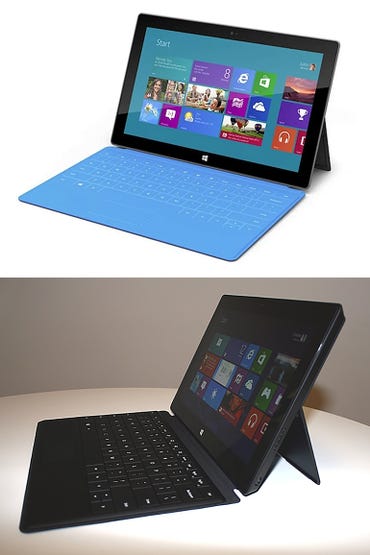
Top: Surface RT (2012). Above: Surface Pro (2013).
Images: ZDNet
The LA launch (which was not gremlin-free) set the scene for Microsoft’s arrival in the PC hardware market, with slim, lightweight tablets and removable keyboards, plus a built-in kickstand for use on desk and (more awkwardly) lap. The first Surfaces were touch-first Nvidia ARM-based devices, and were shortly followed by Intel-powered Pro models with pen support.
SEE: The best Surface PC: Which Windows 11-ready Surface device is right for you?
Over the past decade, the Surface range has evolved from these beginnings to include laptop devices like the Surface Book and the Surface Laptop Studio, and even to foldable Surface Duo phones running Android. All have excellent displays, designed to show two documents side by side.
Today’s Surface family covers everything from robust educational laptops to slim lightweight always-connected devices, to creator-focused convertibles, to an all-in-one desktop PC and huge collaboration screens. There’s a device for all budgets and for most use cases, with some models supporting 4G LTE connections and offering front-facing infrared-equipped webcams for Windows Hello facial authentication.
Here’s what the current line-up looks like.
Surface Pro 8
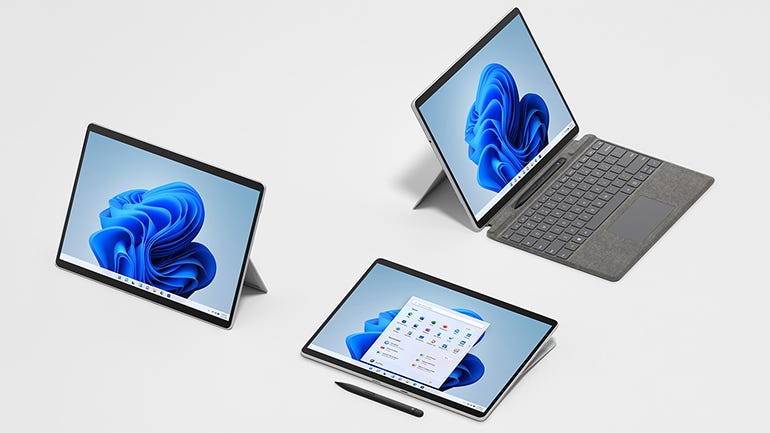
Image: Microsoft
The latest version of the classic Surface tablet, the Surface Pro 8 has a new design that makes it thinner and lighter, building on cues from the ARM-based Surface Pro X. It’s a powerful machine, with an excellent screen and long battery life. You can add the familiar Type Cover removable keyboard, as well as a Surface Pen.
SEE: Six reasons I’m replacing my Surface Pro 7 with a Surface Pro 8
Surface Pro 7+ for Business
|
Announced |
|
|
Form factor |
2-in-1 detachable (12.3-inch) |
|
Price (from) |
$699.99 |
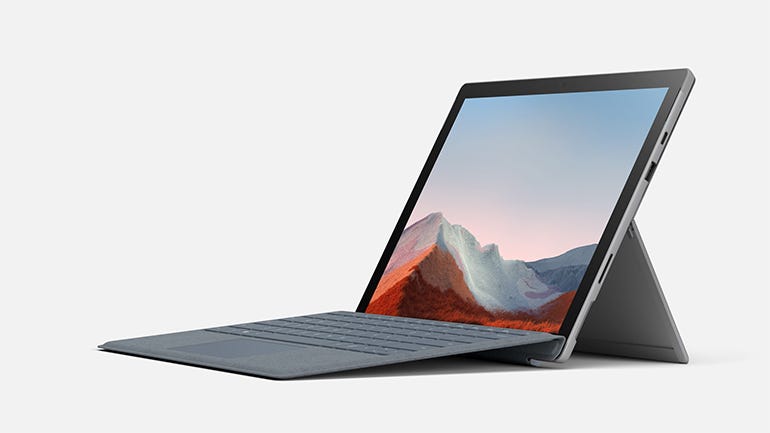
Image: Microsoft
Microsoft’s business-focused Surface Pro 7+, announced in January 2021, is the workhorse of the family. The last iteration of the design introduced with the Surface Pro 3, it was the first Intel-based Surface to have removable storage, allowing you to upgrade the built-in M.2 2230 SSD.
SEE: Surface Pro 7+ for Business: Here’s what makes it different
Surface Pro X
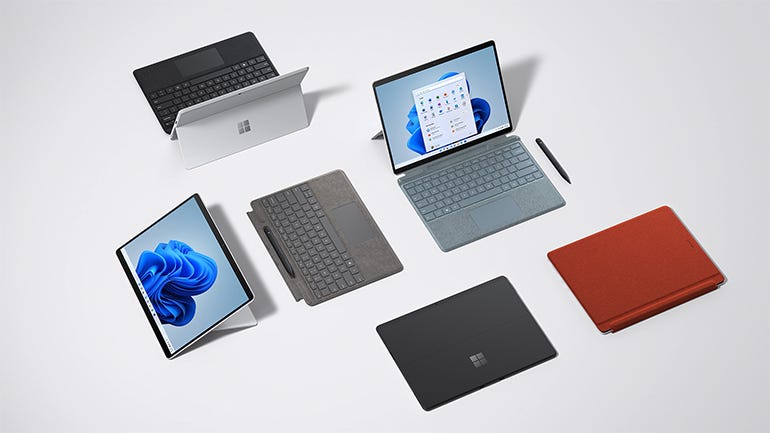
Image: Microsoft
The return of the ARM-based Surface, the Surface Pro X is a light and powerful machine that runs full Windows and supports x86 binaries as well as ARM apps on Microsoft’s own SQ2 processor (a modified version of Qualcomm’s Snapdragon 8cx Gen 2). The versions announced in October 2020 came with built-in 4G LTE for always-on connectivity, with Microsoft adding a more affordable (-$150) Wi-Fi-only version in September 2021.
SEE: Microsoft Surface Pro X review: Desirable but expensive hardware, work-in-progress software
SEE: I upgraded the SSD in a Surface Pro X. This is how it went
Surface Go 3
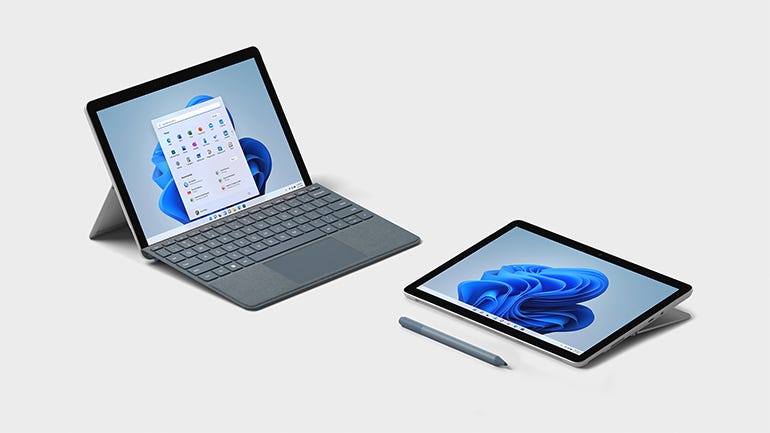
Image: Microsoft
If the Surface Pro is Microsoft’s pro tablet, the Surface Go is the consumer edition. The Surface Go 3, announced in September 2021, is small and light, and best thought of as a 10.5-inch version of the larger Surface Pro, with either a Pentium Gold or Core i3 processor. It’s not the most powerful tablet on the market, but it is one of the cheapest and a 4G LTE option makes it a good option for a low-cost, carry-along device.
SEE: Microsoft Surface Go 3 review: A portable and versatile 2-in-1, but battery life disappoints
Surface Laptop Studio
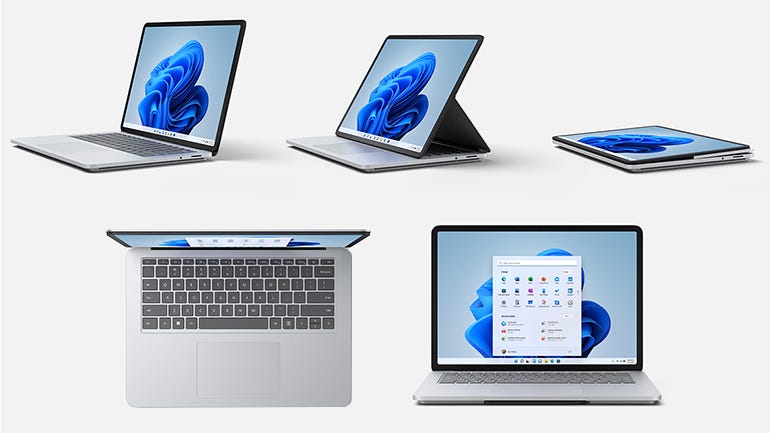
Images: Microsoft
The current Surface flagship, part of the wave of new hardware announced in September 2021, is the Surface Laptop Studio, which replaces the Surface Book. Instead of a removable screen, Microsoft has added a second hinge, so you can fold the display over the keyboard, turning the Laptop Studio into a 14-inch tablet. There’s plenty of horsepower too, with an 11th generation Intel processor and a discrete Nvidia GPU.
SEE: Microsoft Surface Laptop Studio review: A true convertible, with designer appeal
Surface Laptop 4
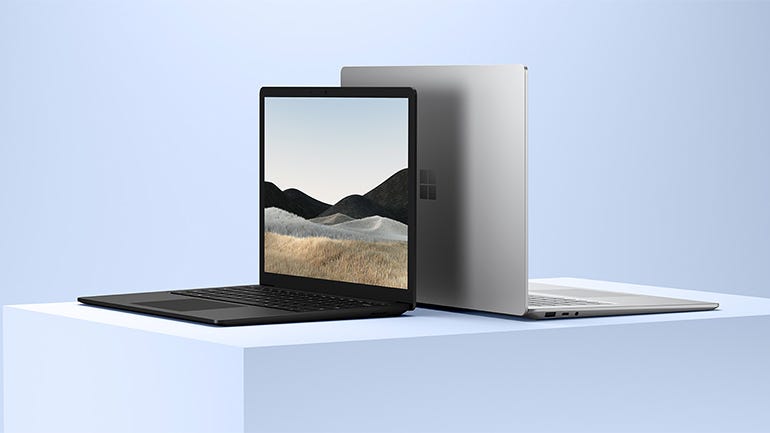
Image: Microsoft
The workhorse of the Surface range, the Surface Laptop 4 comes in both 13.5-inch and 15-inch versions, as well as with Intel or AMD processors. It’s a great everyday machine, offering both touch and pen support in a lightweight laptop form factor. The latest versions have removable storage, making them easier to repair and upgrade.
SEE: Microsoft Surface Laptop 4 (13.5-inch, AMD) review: Sleek, stylish, speedy and sensible
Surface Laptop Go
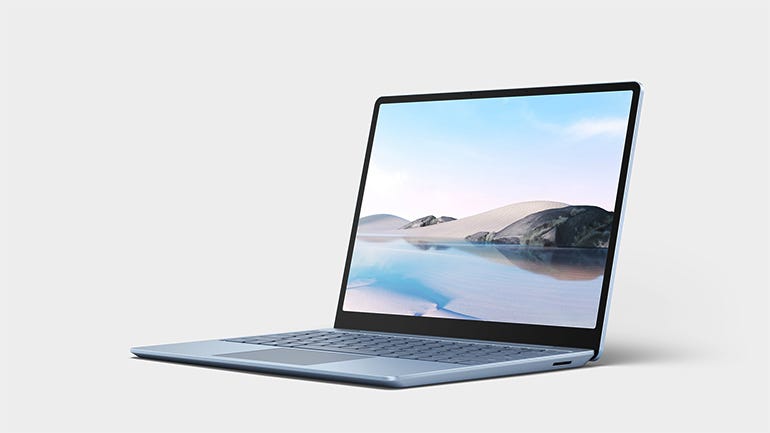
Image: Microsoft
The Surface Laptop Go is the budget Surface, built around Intel’s Core i5 processor. It was the first Surface to use plastic components in its case, and also removed pen support to keep the cost down. Small and light, it’s ideal for many home users and for education. Launched in October 2020, the Surface Laptop Go is among the oldest members of the current line-up.
SEE: Surface Laptop Go: Microsoft’s smaller, cheaper budget PC is easy to recommend
Surface Laptop SE
|
Announced |
|
|
Form factor |
Laptop (11.6-inch) |
|
Price (from) |
$249 (education channels only) |
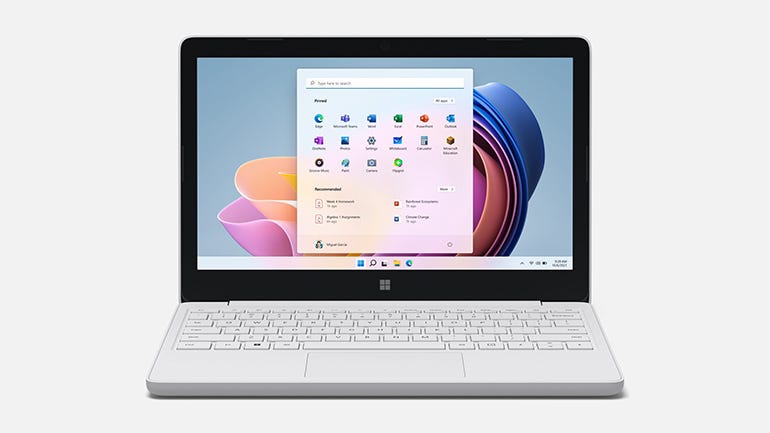
Image: Microsoft
Unlike the rest of the Surface family, the Surface Laptop SE isn’t available through traditional consumer channels. That’s because it’s designed for educational users, and is the Microsoft equivalent of a school-managed Chromebook. It runs the locked-down Windows 11 SE for Education operating system, which needs to be managed through Microsoft’s Intune cloud-hosted management platform. The Surface Laptop SE was announced in 2021, but only became available for purchase from educational suppliers in early 2022.
SEE: Microsoft introduces Windows 11 SE, new $250 Surface Laptop SE for education market
Surface Duo 2
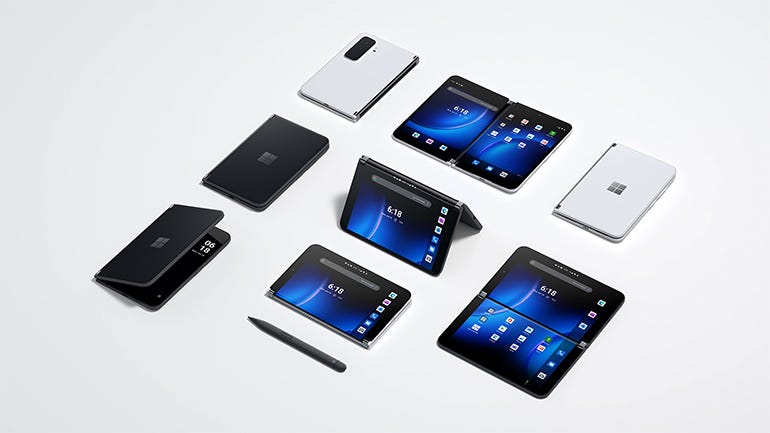
Image: Microsoft
When Microsoft cancelled its Andromeda project, it was assumed the Surface phone would never appear. However, we’re now two generations into Microsoft’s folding phone experiment, with the Surface Duo 2 becoming available in October 2021. The second Android-powered Duo adds better cameras and a flagship-grade processor, as well as support for a built-in pen charger. Taking lessons from its Windows-based tablet stablemates, the Surface Duo 2 is a lot more than a phone – especially when paired with the Surface Pen.
SEE: Microsoft Surface Duo 2 review in progress: Two weeks in and I’m as confused as I am intrigued
SEE: The best foldable phones: Is Samsung still leading the pack?
Surface Studio 2
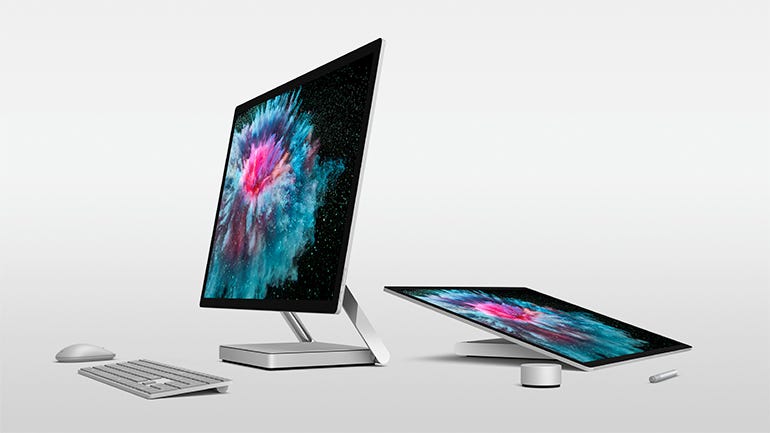
Image: Microsoft
The only desktop PC in the Surface family, the Surface Studio 2 is getting distinctly long in the tooth, having originally launched back in October 2018. In fact, Microsoft had to make it an exception to the hardware requirements for Windows 11. But the smoothly hinged 28-inch display makes it a desirable platform for designers and other creative users, as it can be easily adjusted from conventional orientation to drafting-board mode.
SEE: Microsoft Surface Studio 2 review: A powerful digital drawing board
SEE: The 6 best all-in-one computers: Efficiency and elegance on the desktop
Surface Hub 2S
|
Announced |
|
|
Form factor |
Interactive whiteboard (50-inch, 85-inch) |
|
Price (from) |
$8,999.99 |
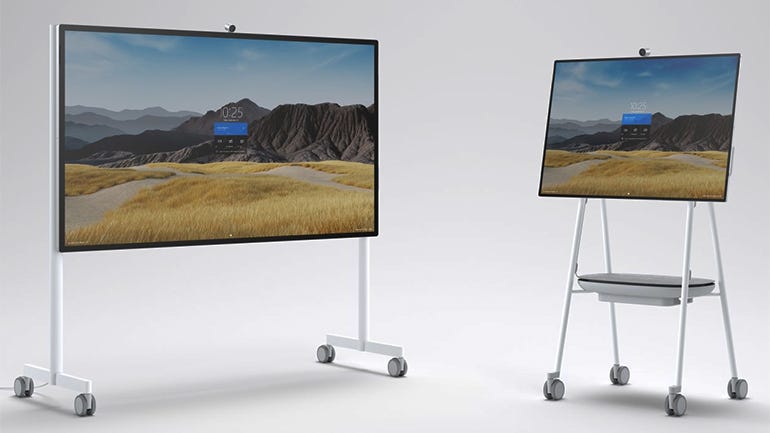
Image: Microsoft
The Surface Hub 2S is Microsoft’s interactive whiteboard, designed for collaborative work in meetings and as a conferencing tool for shared workspaces. Launched in April 2019, it runs a dedicated version of Windows 10, is focused on teams rather than individuals, and has a separate 4K video-conferencing camera. As well as working as a meeting hub, the Surface Hub 2S is available as a remote display, so you can project screens and control it from any Windows PC.
SEE: Microsoft brings Windows 10 Pro, Enterprise to Surface Hub 2S
What’s next for Surface?
Surface Laptop Go 2
The most obvious next move is an update to the Surface Laptop Go. While the Surface Laptop Go 2 is rumoured to be due in May, I suspect that Microsoft may hold off in order to avoid a collision with Build (24-26 May) and tie in a launch with the 10th anniversary of the Surface’s announcement (18 June).
Surface Pro 9
There won’t be much change to the physical design of Surface Pro hardware in 2022, as the Surface Pro 8 was a big change and Microsoft likes to keep its basic form factors stable for long enough to allow partners to deliver cases and other accessories. However, there may be an upgrade to the Surface Dock 2, which is more suited to older hardware as it lacks Thunderbolt 4 support.
SEE: Best laptop docking stations: Transform your workspace
Surface Pro X 2 (SQ3)
Qualcomm has a new generation of PC-grade ARM processors, and these are likely to form the basis of a Microsoft updated SQ3 for a new Surface Pro X, adding Microsoft’s own machine-learning hardware to the SoC, which continues to improve. With Windows on ARM support now available in Azure, Microsoft is close to having an end-to-end ARM-based development environment, which should make it easier for developers to build and test ARM versions of their applications without needing Qualcomm’s woefully under-powered (and US-only) ARM developer hardware. There have been recurring rumours of desktop developer hardware from Microsoft, but with Azure ARM support available, there’s now little need for it.
Surface Duo 3
On the phone side, much of Microsoft’s 2022 focus on the Surface Duo will be on software. The company has shipped versions of Android 11 for both first- and second-generation hardware, with an Android 12 update waiting on the completion of Google’s large- and dual-screen Android 12L update. Due later this year, Android 12L should allow Microsoft to push much more of a custom experience to its folding Surfaces, as it will be able to build on Google’s APIs rather than develop its own Android extensions. With improved software, a third version of the Duo would be able to ship in 2023 with the next generation of Qualcomm’s 5G hardware.
Surface Neo
We’re unlikely to see the much-delayed dual-screen Surface Neo – announced back in October 2019 – in 2022. Originally designed for Intel’s Lakefield processor family, the big.little core model it used is now part of the 12th generation chipset. The current chipset family is still a bit on the over-powered side for a small, always-connected companion device like the Neo, and so, with dual-screen Windows on the backburner after the cancellation of Windows 10X and with silicon supply chains still constrained, we’re likely to have to wait for another iteration of Intel’s technology before chipsets are ready for the Neo to finally make its appearance.
Surface Studio 3
A possible surprise on the horizon could be a new version of the Surface Studio. Stocks of the Studio 2 seem to be running low, which either means the end of the line or new hardware on the way. With a big anniversary around the corner, could a new Surface Studio 3 allow Microsoft to set a new direction for desktop computers and the all-in-one form factor?
After all, even with a tiny production run, Apple’s 20th Anniversary Macintosh was an innovative desktop device that incorporated many of the features we now expect from a desktop PC. Could a 10th Anniversary Surface Studio push the envelope in a similar way? With Microsoft continuing to come up with innovative hardware like the Surface Laptop Studio, it’s clear that anything could happen.
Also see:
For all the latest Technology News Click Here
For the latest news and updates, follow us on Google News.
